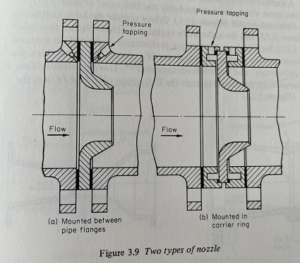A nozzle is a device designed to control the direction or characteristics of a fluid flow (especially to increase velocity) as it exits (or enters) an enclosed chamber or pipe.
Nozzles can be used in two quite different ways: as differential pressure meters for liquids and gases; or as sonic (critical) velocity regulating and metering devices for use with gases only.
Nozzles as differential pressure meters
Nozzles designed to be used as differential pressure meters are illustrated in Figure 3.9. They are more costly than orifice plates but have three advantages over them: they have a discharge coefficient very much closer to unity; they can be used to discharge directly into the atmosphere, and they have no sharp edge to become blunted so that they can be used with dirty and abrasive fluids.
Sonic Nozzles for gas flow
Provided the pressure drop across a nozzle is sufficient to ensure that the gas reaches sonic velocity in the throat, that velocity will be maintained within very close limits, and hence the (constant) volumetric flow rate through the nozzle can be calculated accurately. Although the volumetric flow rate through a given nozzle cannot be altered, the mass flow rate can be varied within fairly wide limits by varying the gas pressure and hence the density of the gas. If the nozzles is connected on the downstream side to a gradually tapered expansion, the resulting device is known as a sonic venturi-nozzle; much of the upstream pressure is recovered in the tapered expansion so that the total head loss in the sonic venturi-nozzle is quite small.
The principal use of sonic nozzles and sonic venturi-nozzles is in the calibration of other types of the gas meters.

